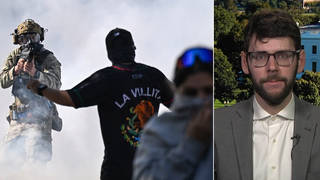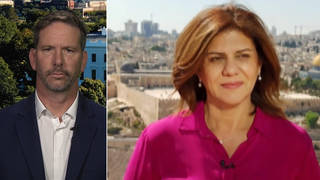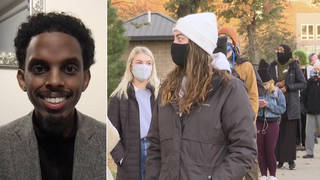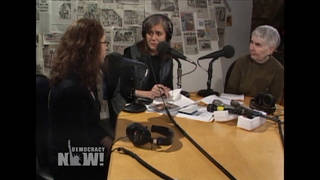
Topics
We hear an excerpt of a new documentary by the Media Education Foundation, “Hijacking Catastrophe: 9/11, Fear & the Selling of American Empire” which examines how the Bush administration used Sept. 11 to transform American foreign policy and enter a phase of so-called preemptive warfare while rolling back civil liberties and social programs at home. [includes rush transcript]
A new documentary “Hijacking Catastrophe: 9/11, Fear & the Selling of American Empire” examines how the Bush administration used Sept. 11 to transform American foreign policy and enter a phase of so-called preemptive warfare while rolling back civil liberties and social programs at home.
The film is produced by the Media Education Foundation and features former government officials combined with many of the leading scholars and thinkers of our time including Noam Chomsky, Norman Mailer, Chalmers Johnson, Daniel Ellsberg, Tariq Ali and more. The film is narrated by Julian Bond.
- Sut Jhally, director of the new documentary “Hijacking Catastrophe: 9/11, Fear and the Selling of American Empire.” He is a professor at the University of Massachusetts and the founder and executive director of the Media Education Foundation.
- Hijacking Catastrophe, excerpt of documentary.
Transcript
AMY GOODMAN: We’re going to start, though, with the man who produced this film at Media Education Foundation, his name is Sut Jhally director of Hijacking Catastrophe, a professor at the University of Massachusetts. Welcome to Democracy Now!
SUT JHALLY: Good morning, Amy.
AMY GOODMAN: It’s interesting to talk to you, Sut, from Buffalo, a city that has suffered from the aftermath of 9/11, to talk you to, who have come to New York, and now are in our Firehouse Studios, just blocks from Ground Zero. Can you introduce Hijacking Catastrophe, why you made it?
SUT JHALLY: When we sat down to think about this film about a year ago, myself and the co-director and producer of this, Jeremy Earp, we wanted to do two things: We wanted to explain clearly what exactly the war in Iraq was about. Given that the lies of the Bush administration are totally unraveling, the lies about the weapons of mass destruction, the lies about Saddam Hussein being connected to Osama Bin Laden. We wanted to get at the real reasons for the war. To do that, we have to trace back the influence of a small right wing cabal within this Bush administration. And the plans that they had laid out for the invasion of Iraq actually ten years ago. On one hand, we wanted to give Americans a clear explanation of why exactly are we in this mess in Iraq and the incredible costs that are being paid in terms of dead and maimed American soldiers, tens of thousands of dead Iraqis and billions of dollars flowing out of this country. What are the reasons for that. That was one reason. The other thing we wanted to do, we tried to anticipate a year ago, what exactly the Republican strategy would be to try and sell this crazy war. And in fact, after looking at the convention last week, we actually hit it almost dead on. We knew that they would be evoking the memory of 9/11. We knew they would be trying to scare people so that they would not think clearly about what was going to be going on. And that they would be presenting themselves as strong leaders and also denigrating the Democrats as, as Arnold Schwarzenegger said, as “girlie men.” So we also wanted to look at the selling of this. The film does both. The film looks at why we’re there and also how this crazy agenda has been sold to the American people. What’s really interesting is when Paul Wolfowitz first came up with this in 1992, Paul Wolfowitz is now Deputy to Rumsfeld in the Department of Defense. When he first wrote, in 1992, the tail end of the first Bush administration, he wrote something called “The Defense Planning Guidance.” In this was the first laying out of a post-Cold War era strategy for America, in which they would become, in which America would become the sole superpower for essentially forever. When this was first announced in 1992, everyone thought was crazy. People within the administration thought he was crazy. Joseph Biden was the leading Democrat at that time. He could barely speak when he heard this. Our European allies were up in arms. Now what is really interesting is: What was crazy in 1992, by 2002 had become official government policy. And what we look at is how 9/11 was used to sell that, how the fear and anxiety engendered by 9/11 was used by this administration to push through this agenda that they could not have gotten any other way.
AMY GOODMAN: We’re talking to Sut Jhally, who is the director of this new film, Hijacking Catastrophe. He is the Executive Director of the Media Education Foundation. Let’s take a look and a listen to a clip of Hijacking Catastrophe: 9/11, Fear and The Selling of American Empire. In this clip, we begin with the Nobel Peace Prize Laureate, Jody Williams.
JODY WILLIAMS: I understand that they want the American public to believe that the invasion of Iraq was the response to September 11. I think it is a lie. I believe that it is part of a neoconservative agenda to assert that American hegemony is untouchable, and September 11 gave them the opportunity to put in play plans that they had been considering since the first Bush administration.
NARRATOR: In all of its previous incarnations and long before 9/11 and the current war on terror, the Wolfowitz doctrine had identified regime change in Iraq as a crucial first step towards global domination by force. In a widely circulated letter to President Bill Clinton in 1998, the members of the Project for the New American Century challenged the President to act forcefully and militarily to remove Saddam Hussein from power. Two years later, George W. Bush would hand-pick many of these same neoconservatives for key foreign policy posts in the Pentagon and State Department. Once installed in government positions, as recent interviews with a number of former members of the Bush administration have revealed, the group maintained its long-standing focus on Iraq, a focus that intensified after the attacks of September 11.
MARK DANNER: In the meetings of the inner sanctum of the Bush administration, the attack on Iraq was brought out from almost the first days. Even though there was no evidence whatever that the Iraqis had been involved in this.
RICHARD CLARKE: They dragged me into a room with a couple of other people, shut the door, and said, I want you to find whether Iraq did this. George Bush wanted me to come back with a report that said Iraq did this.
PAUL O’NEILL: From the very beginning, there was a conviction that Saddam Hussein was a bad person, and that he needed to go.
NARRATOR: Just five hours after American airlines Flight 77 struck the Pentagon, and without any evidence linking Saddam Hussein to the attacks of 9/11, Defense Secretary Donald Rumsfeld was already ordering his aides to draw up plans for striking Iraq. The notes quote Rumsfeld as saying he wanted: “Best info fast. Judge whether good enough hit S.H.,” meaning Saddam Hussein. “Go massive,” Rumsfeld continued in the notes. “Sweep it all up. Things related, and not.”
ROBERT JENSEN: The problem for the Bush administration is that plans that had already existed for regime change in Iraq had to be justified. They could not just go in without public support. The public support was creating by connecting Saddam Hussein to those fears of terrorism. The fear generated by 9/11, the fear of terrorist networks has to be transferred to Iraq, that is, the American people have to learn to be as afraid of Saddam Hussein as they are of Osama Bin Laden.
NARRATOR: Soon after September 11, Defense Secretary Donald Rumsfeld set up a small intelligence office in the Pentagon, the Office of Special Plans to create the rationales for the already planned attack on Iraq. To convince people that Saddam Hussein possessed weapons of mass destruction, and that he was linked to Al Qaeda and 9/11. Lieutenant Colonel Karen Kwiatkowski worked in the Pentagon’s Near East and South Asia Office. She witnessed how the Office of Special Plans issued talking points about Iraq for senior government officials allegedly based on intelligence.
KAREN KWIATKOWSKI: The information there drawn from fact. You can find bits and pieces of fact throughout, but framed, articulated, crafted to convince someone of what? Well, of things that weren’t true. Things that were not true. 9/11, Al Qaeda related to Saddam Hussein, possibly some involvement there.
GEORGE W. BUSH: The liberation of Iraq is a crucial advance in the campaign against terror. We have removed an ally of Al Qaeda.
KAREN KWIATKOWSKI: The very things that a year later, President Bush himself denies, and feigns his surprise: “I don’t know why everybody thinks that.”
GEORGE W. BUSH: We’ve had no evidence that Saddam Hussein was involved with September 11.
KAREN KWIATKOWSKI: I worked in a place where they concentrated on preparing this story line and selling it to everybody they could possibly sell it to.
ROBERT JENSEN: It wasn’t the failure of intelligence, it was the manipulation of intelligence to achieve a political goal. They were disciplined. They stayed on message, they marshaled all of their forces in this relentless public relations campaign to convince the American people that there was a threat from Iraq.
NEWS ANNOUNCER: Day four of the Bush team’s full court press giving speech after speech after speech and issuing reports.
DONALD RUMSFELD: The United States knows that Iraq has weapons of mass destruction. Any country on the face of the earth with an active intelligence program knows that Iraq has weapons of mass destruction.
COLIN POWELL: There is no doubt that Saddam Hussein now has weapons of mass destruction. There is no doubt that he is amassing them to use against our friends, against our allies and against us.
GEORGE W. BUSH: The choice is his — and if he does not disarm, the United States of America will lead a coalition and disarm him in the name of peace.
KAREN KWIATKOWSKI: And the President’s mouth, the Vice President’s mouth these same things that were given to us to put into our superiors, the senior civilian leadership’s mouths — he said things that were us to put to our theories now. These were not based on intelligence that we saw and everyone saw. They were based on a very selective reading of the intelligence and a creative packaging that you could put through these two big points that the President and Vice President and the whole neoconservative community used to justify this pre-emptive war on Iraq.
AMY GOODMAN: That was Karen Kwiatkowski, former Pentagon employee, part of the documentary, Hijacking Catastrophe: 9/11, Fear and The Selling of American Empire. It is produced by Sut Jhally the Media Education Foundation in Western Massachusetts. Sut Jhally is in our New York studio. I’m here in Buffalo. Sut Jhally, can you talk about the power of these films at this time? You have got Hijacking Catastrophe, your film. There’s Outfoxed, the film by Robert Greenwald. Of course, Michael Moore’s, Fahrenheit 9/11, the significance of them coming now?
SUT JHALLY: I think Robert Greenwald’s Outfoxed, and Michael Moore’s, Fahrenheit 9/11, showed the tremendous need and desire there is for people for new information at this time. I think the effects of these films we’ll only find out once the election has been held. The key to that is these films are — the key to the films is not only that they’re produced, but they’re watched, that they’re used, they’re used by activists and they engage with what’s going on at that time. So distribution, I think is the most important aspect of this. I have been very encouraged by how widespread these films have been. Our film is opening tonight at Cinema Village in New York. It’s opening in theaters around the country as well, but only a small number of them. I really support people to support independent film. We are also distributing this film through our website. We want this film to be available now, and so in fact these films have also indicated a new way to distribute which is not just theatrical, we can distribute in DVD at the same time. The website is http://hijackingcatastrophe.org/. We want to encourage people to get it now and show it to their friends. People that you wouldn’t normally talk to about those things. Take it to your cable access station and show it.
AMY GOODMAN: Briefly, the purpose of the Media Education Foundation?
SUT JHALLY: We make films and videos to do with the media’s effect on society. What we really try to do is take the latest cutting edge academic research and translate it into an accessible form, so you don’t have to be an expert to understand it and to make knowledge in the University really matter in the world out there. I can’t think of a more important time for that to happen than in the next eight weeks coming up to this election. Hijacking Catastrophe is an attempt to take what we know, the latest cutting edge research that we know, the truth that we know, to put it in an accessible form so that ordinary people can engage with the most important issues of day.
AMY GOODMAN: And again your website.
SUT JHALLY: Our website is http://hijackingcatastrophe.org/. We are committed to getting this out in a major way. We have priced it very affordably. People can get it for $20. We hope that people will take it and use it as much as possible between now and November 2nd.
AMY GOODMAN: And it’s opening in tonight in New York at Cinema Village and can open anywhere in the country, just ask your movie theater. Sut Jhally, thank you for being with us. Professor at the University of Massachusetts, Founder and Executive Director of the Media Education Foundation.












Media Options